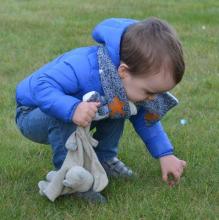
What are Perceptual Motor Skills?
Perceptual motor skills refer to a child’s developing ability to interact with his environment by combining the use of the senses and motor skills. This is viewed as a process where visual, auditory, and tactile sensory abilities are combined with emerging motor skills to develop perceptual motor skills.1
Perception refers to the process of taking in, organizing, and interpreting sensory information, while motor skills refers to the ability to control the body’s movements including the movement of the eyes. Gross motor skills include the movement of large limbs or the whole body as in walking. Fine motor skills are developed with the use of the fingers to grasp and manipulate objects.2
There is a mutual dependency between perceptual information and voluntary motor activity. Perceptual abilities are learned and rely upon movement as the way to obtain this learning. Conversely, movement involves a perceptual awareness of sensory stimulation to develop satisfactorily. When functioning normally, this reciprocal interaction is generally done naturally and informally as children explore and play. However, formal training in physical education programs and special remedial therapies are also helpful in developing perceptual motor skills.3
These perceptual motor skills include body awareness, spatial awareness, directional awareness, and temporal awareness. Body awareness involves being able to locate body parts and understand the function of them. Spatial awareness is being aware of the space occupied by the body and how to position and maneuver in it. Differentiating between left and right, front and back, top or bottom, and up and down involve directional awareness. Temporal awareness is the ability to understand the concept of time passing, the sequence of events, and the prediction of how soon moving objects arrive.4
Activities in perceptual motor skills include:
- Gross motor activities: throwing, catching, kicking, jumping, swinging
- Fine motor activities: cutting, lacing, hammering, buttoning, pouring
- Body awareness activities: naming, pointing, identifying, moving, and performing tasks using body parts
- Spatial awareness activities: moving, exploring, locating, comparing, and identifying using walking, running, catching, rolling, tunnels, mazes
- Directional awareness activities: moving, stationing, pointing, identifying, and imitating using the body, objects, and apparatus
- Balance activities: walking, bounding, and clapping using balance beams and boards, trampolines, and spring boards
- Integration activities: hitting moving balls, tracking moving objects, matching visual and motor responses, and responding to auditory signals
- Expressive activities: art, music, dance, and dramatic play5
Adequate perceptual motor skills enable children to enjoy better coordination, greater body awareness, stronger intellectual skills, and a more positive self-image. Difficulties in reading and writing can be a direct result of poor perceptual motor development. Physical activity builds neural pathways in the brain, which help prepare children to learn. Improving perceptual motor skills can affect a child’s ability to learn.6
Motor skills have been found to be developed naturally during free play, especially on a well-developed playground. Although actual skill training can be helpful in physical education classes, it has been seen that children are much more active in unstructured play. Children with limited motor abilities benefit from both free play and structured training in motor skills that include coordination, speed, power, agility, balance, locomotor skills, stability movement activities, and gross and fine motor skills.7
Some children with difficulties in developing perceptual motor skills are affected by a brain-based condition called dyspraxia, which affects roughly 6 to 10 percent of children. Although the causes of dyspraxia are not clearly understood, indicators for the condition may be genetics, premature birth, low birth weight, or exposure to alcohol in the womb. Dyspraxia makes it hard for children affected to be able to plan and coordinate physical movement slowing their development of gross and fine motor skills. It can also affect their mouth and tongue movements and cause difficulty in speaking clearly. Occupational therapists, speech therapists, and perceptual motor training can help to improve children’s language, visual, movement, and hearing and listening skills.8
- 1. Frost, Joe L., Sue Wortham, and Stuart Reifel. Play and Child Development. Upper Saddle Valley, NJ: Prentice-Hall, 2001. pp. 132-133.
- 2. Perceptual and Motor Development Domain.” California Department of Education. < http://www.cde.ca.gov/sp/cd/re/itf09percmotdev.asp > 30 June 2016.
- 3. Frost, Joe L. Play and Playscapes. Albany, NY: Delmar Publishers Inc., 1992. pp. 44-46.
- 4. C., Jennifer. “Perceptual and Motor Skills: Move That Body!” Udemy. < https://blog.udemy.com/perceptual-and-motor-skills/ > 30 June 2016.
- 5. Op. cit., Frost. Play and Playscapes.
- 6. Johnstone, Jill A. and Molly Ramon. “Helping children develop to their full potential through perceptual-motor experiences.” Human Kinetics. < http://www.humankinetics.com/excerpts/excerpts/helping-children-develop-to-their-full-potential-through-perceptual-motor-experiences > 30 June 2016.
- 7. Op. cit., Frost. Play and Playscapes. p. 47.
- 8. Patino, Erica. “Understanding Dyspraxia.” Understood. < https://www.understood.org/en/learning-attention-issues/child-learning-disabilities/dyspraxia/understanding-dyspraxia > 30 June 2016.

